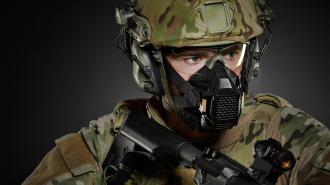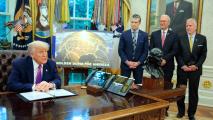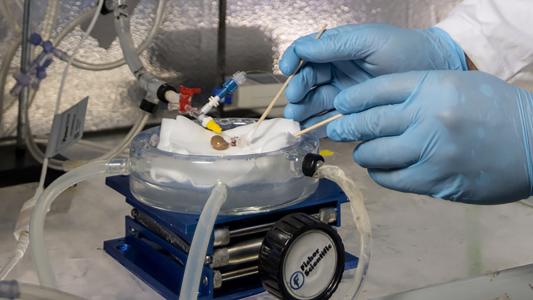Arjun Grewal, who spent two decades in the Canadian Armed Forces in infantry and special operations, saw the burn pits, which perch on the edges of military bases in Iraq, Syria, and, in his case, Afghanistan.
All sorts of things were condemned to these infernos: computers, chemicals, Styrofoam, scraps of food, wood, and plastic; fuel, munitions, medical waste, human waste — all of it set aflame and aloft, sometimes in black clouds ejected into the air, like toxic octopus ink.
That smoke would encircle the entire base that Elizabeth Hilpert, a defense contractor, worked at, and then fall to the ground at night, Hilpert told PBS NewsHour. At Joint Base Balad in Iraq, the plume was ever present — black silt and powdery sand coated everything. (Balad’s burn pit was particularly massive, the Military Times reports — almost ten acres.)
These pits were sometimes a necessary evil, especially in an active war zone. But they were also highly toxic and highly hazardous, Grewal tells Freethink.
He never saw protection beyond a wet scarf wrapped around a face.
The Protection Gap
Grewal knows what he wished he had back then: a respirator to protect him against exposure — something light, tough, easy to use, and optimized for the needs of the military. Now, he’s building it.
Grewal is the CEO of Ventus Respiratory Technologies, a company focused on respiratory protection for military, police, and first responders. In late May 2023, Ventus announced that they were ramping up international field trials of the company’s mask, the TR2. Covering only the mouth and nose — like a less-menacing, more practical version of the mask Tom Hardy wore as Bane — the TR2 is designed to be less burdensome than a gas mask, but better suited to its task than civilian options.
The trials come after the mask received CE certification in February, passing the European Union’s standards for health, safety, and environmental protection.
Over 95% of combat veterans self-reported some form of chronic health condition after deployment, many possibly caused by toxic exposure.
There is a protection gap for military members and first responders, Grewal and other sources tell Freethink, a gap the TR2 is meant to help cover.
Clear and present dangers — IEDs and bullets, raging structure fires and drug lab raids — are typically covered by protective equipment. Soldiers get armor and gas masks to protect against chemical or biological agents; firefighters have an SCBA, the air tank and mask they wear inside a blaze.
But these jobs also contain hazardous exposure risks that are less obvious. There’s the aerosolized lead being breathed in at the gun range, the smoke particulates and chemicals that stray far from the burning building, the fumes from standing next to highways for hours on end responding to accidents — even the pathogens released by decomposing bodies encountered by first responders.
In the military alone, there are many potentially harmful exposures every day, Jack Ratliff, an Army veteran and nurse practitioner, says. Ratliff is the director of education at the HunterSeven Foundation, a nonprofit that studies the long term effects of exposure-related illnesses, educates healthcare providers to increase awareness, and provides assistance to veterans and their families.
Chronic bronchitis, various lung and respiratory conditions, and cancers are connected to toxic exposure.
The impact of exposure-related illness is starting to come to light, driven by grassroots efforts from the veterans themselves and journalists like the Military Times’ Kelly Kennedy. Previous research found that over 95% of combat veterans self-reported some form of chronic health condition after deployment, many possibly caused by toxic exposure. First responders like police, firefighters, and EMTs commonly report chronic health conditions, too.
Illnesses like chronic bronchitis, post-deployment diagnosed asthma, various lung and respiratory conditions, and cancers are connected to toxic exposure, as well as mental health conditions and a constellation of symptoms resembling PTSD.
The recently passed PACT Act acknowledges the situation, expanding VA health care and benefits for veterans with exposure-related illnesses. Since the act’s passing in April 2023, the VA announced that veterans and their survivors have filed over 500,000 claims for toxic exposure-related benefits, and over 3 million have received the VA’s new toxic exposure screenings.
Grewal sees the TR2 as a way to help cover the protection gap, protecting military members and first responders from routine hazards to prevent them from becoming what PACT cosponsor Representative Raul Ruiz, D-CA, called “delayed casualties of war.”
The Mask
In basic training, you get issued all of your standard equipment. Among that kit is a gas mask — the kind you’re picturing right now, with the canisters like cut tusks, heavy-duty respirator, and full face coverage, known as a CBRN (chemical, biological, radiological, and nuclear defense) mask.
“I categorize that as a very ‘low probability, high threat’ piece of protection,” Grewal says.
The chances of being exposed to the threats these masks are intended to protect against — chemical weapons, nerve gas, weaponized pathogens — are low. On the other hand, the chances of being exposed to exhaust, fumes, weapon discharge, smoke, and other toxic exposures is basically guaranteed. Gas masks are an important piece of equipment, Grewal says, but they’re impractical to be worn routinely; what’s often missing is protection for threats below their danger level.
“Our mask is designed to be lightweight, low burden, and allow you to operate in those high probability, medium threat environments.”
Arjun Grewal
Firefighters run into the same protection gap, says Jadie Miller, a veteran firefighter who has worked with multiple departments in Ontario and is the founder and CEO of Pyroc, which works to protect first responders for long and effective careers.
While their 25-lb. SCBA gear is designed for the “hot zone,” they need options made for the dangers of the “warm zone,” the region outside the fire itself but still potentially bathed in toxins.
There are many civilian masks designed to protect against what the TR2 protects against, including the kind you see worn by carpenters and demolition workers, and the now-familiar N95, but these run into a different problem: most simply aren’t designed for the kind of work a soldier or first responder may need to do.
“Our mask is designed to be lightweight, low burden, and allow you to operate in those high probability, medium threat environments that soldiers, police forces, firefighters, wildfire firefighters find themselves in very often,” Grewal says.
The TR2 is made from polycarbonate and medical-grade silicone, with nylon straps. Weight was shaved wherever it could be, and the mask is designed to be easily attached to standard equipment to carry with you.
Small cartridge filters inside the mask replace the large canister of the gas masks — a crucial detail for being able to properly aim and shoot a rifle, says Kynan Walper. A Canadian infantry veteran deployed to Afghanistan and former Ontario police officer, Walper now runs Ghost Risk Management, a consultancy that focuses on advising the government and defense industries.
Walper met Grewal while running evacuations of Afghans for the NGO Aman Lara, in 2021-22. He has been test-driving the mask, wearing it himself and distributing them to his own employees and people training and fighting in various combat zones. (There is no financial connection between Ghost and Ventus, Walper says, although they share office space.)
“You don’t have time to go get that specialized equipment. You have to move now.”
Kynan Walper
For police forces, the mask’s ease of use may be especially helpful. During his career as a police officer, Walper was exposed to numerous situations where a small, easy-to-use respirator would have been welcomed and a CBRN mask was not practical to have around. Consider being called to the house of a hoarder; police forces probably have equipment for this situation, but it’s likely a shared piece of kit, kept at the station.
“If you need to go in to there right away, you don’t have time to go get that specialized equipment,” Walper says. “You have to move now.”
That need for urgency is behind another optimization: the ability to breathe easily through the mask.
“We have a ski hill fairly close to where I live,” says Miller, the firefighter. She wanted to test the TR2 under heavy breathing; the more she wore it, she found, the more comfortable it became.
The mask is also designed to allow the communication that is necessary for soldiers and first responders, but isn’t common for civilian respirators. A mic system can be built directly into the mask and is effective, Walper says.
“I think that the first responder community is ready for change.”
Jadie Miller
The TR2 has been on the market for around a year and a half, and is currently being used, field tested, and evaluated by first responders and military forces around the world, Grewal says — including Delta Force, the Navy SEALS, the special forces of Canada and various European nations, the Royal Canadian Mounted Police, and Alberta Wildfire among others. Some are trialing it in extreme environments, including evacuation actions in Sudan, he says.
Ventus hopes to learn more about comfort and compatibility, feature and design recommendations, and the effectiveness of the filtration in different scenarios, Grewal says. The company plans to test filters that get returned to gather more data on the volume of heavy metals and other chemicals users may be exposed to.
The Fight
That the protection gap is being met by a veteran is not surprising, if one looks at history. It is often through the actions of veterans and first responders, and efforts led by them, that safety risks are exposed, acknowledged, and eventually — potentially — rectified.
“It’s grassroot efforts,” Ratliff, the veteran and NP, says. “Are there smarter guys out there that I wish were doing what I’m doing with HunterSeven? A hundred percent. But I’m the guy with the experience, and I’m someone that’s willing to go out there and do it. And that’s the same thing with our whole team.”
The gap is not necessarily nefarious, Miller says, but the people affected by toxic exposure need to have a seat at the table. “I think that the first responder community is ready for change,” Miller says. “And I think that that’s important to note.”
When near the curling, poisoned smoke of the burn pits; when breaching buildings bathed in dust and particulate; when inhaling gun smoke at the firing range; when being bathed in dust for hours on end during long drives in the turret of a vehicles, he could have used a respirator, Gerwal says.
“It’s an honor to lead this company and help solve a huge problem,” he says. “It is a passion of mine.”
We’d love to hear from you! If you have a comment about this article or if you have a tip for a future Freethink story, please email us at [email protected].






